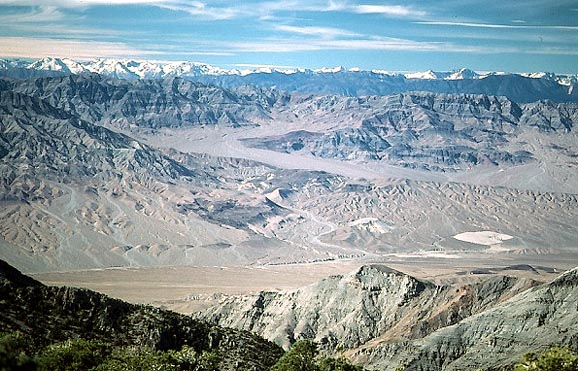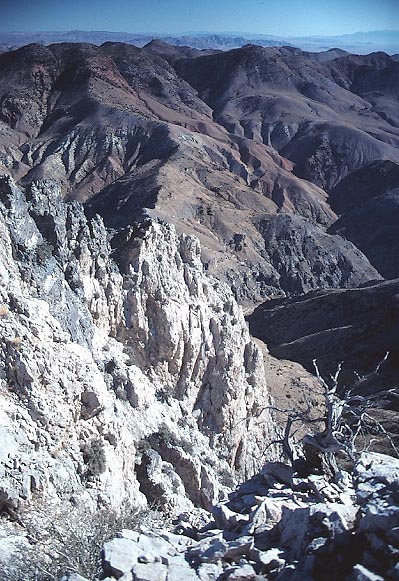 The
vista west extended
across the Death Valley itself, and stretched over to the High
Sierra in the far distance. All now mostly in T-shirts, we savored
the benign temperatures, and lounged about on the summit.
The
vista west extended
across the Death Valley itself, and stretched over to the High
Sierra in the far distance. All now mostly in T-shirts, we savored
the benign temperatures, and lounged about on the summit.GRAPEVINE PEAK (8,738') AND MT. PALMER (7,958') January 13-14, 1996
Carpooling, for the new year, again, to the turnoff for the road to these two peaks, off U.S. 95, I had a cold night with temperatures registered by the truck computer to be down to 14 degrees Fahrenheit. It felt good to get into the car and warm up a bit by driving, using the heater.
Our group of ten motored along the dirt road on the east side of the Grapevine Range, and saw a distant herd of wild burros. One vehicle was unable to drive as far as the 4WD vehicles, so we left it, the two occupants piling into the bigger, high clearance trucks. Driving as far as we needed, we began hiking Grapevine Peak, from below a road saddle.
There is a bit of a use trail, and we summited
quickly, after two hours and ten minutes.  The
vista west extended
across the Death Valley itself, and stretched over to the High
Sierra in the far distance. All now mostly in T-shirts, we savored
the benign temperatures, and lounged about on the summit.
The
vista west extended
across the Death Valley itself, and stretched over to the High
Sierra in the far distance. All now mostly in T-shirts, we savored
the benign temperatures, and lounged about on the summit.
There was a green box of sorts placed several feet off from the true highpoint. These were communications devices, objected to by some as intrusive upon wilderness. The Park Service had been courteous enough to allow for the naturalness of the exact highest point to remain as such.
Upon our hike back, we ran into a NPS ranger who said his instructions were to take a picture of the little green box. We had been hiking single-file on or about the intermittent use trail, which the ranger implied that we were creating. Our leader promptly countered that there would be dozens of use trails if we were all to spread out on our hiking.
With the recent wilderness designation, I suppose we, as the main users of the new wilderness areas, would get some criticism. The DPS does not include some of the careless or destructive, even malicious, users that I have witnessed with other groups in other wild areas. We take pains to clean up and carry out even other peoples' garbage, and leave everything as we encountered it. If our hiking is said then to diminish the resource, let there be rules for everybody.
Back to the trucks, we motored back down to enjoy a lower elevation car camp and another winter, desert night.
The next day, we motored back up to a pass,
and began a longer hike
to the top of Mt. Palmer. One starts about as high as the peak,
but due to the terrain, you have to drop down and re-climb up
the peak proper.
This took us about four hours to the top. A bit of rock scrambling is needed to get here. Jutting out a bit from the range into the Valley, the view was rugged and inspiring. Again, the heat of the sun made things nice, even warm. We hiked back, downclimbing and again a traverse, with a final climb back up to the saddle and the vehicles. After driving out, it was a relief to finish with the bad road driving.
My companion and I sought to do another peak while we were down here. We stopped in Shoshone for eats, I think. Driving south, we drove into the Greenwater Valley to camp, and then make a climb of Smith Peak.
The washboarded dirt road caused a funny noise to begin in the truck, so we had to abort this attempt. It was the same part that failed on the trip the year before. Luckily, we could drive O.K. on pavement. Going south to I-15 on CA 127, we motored home uneventfully.
BACK TO PETE'S THOUSAND PEAKS HOME PAGE